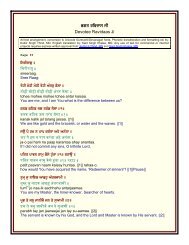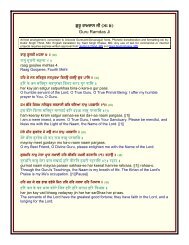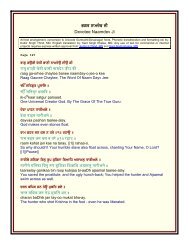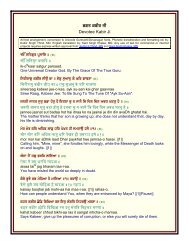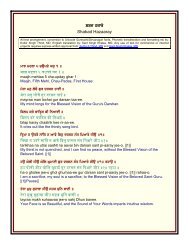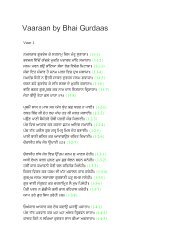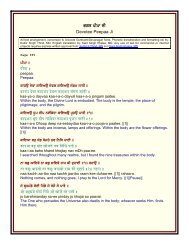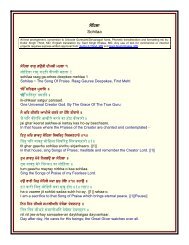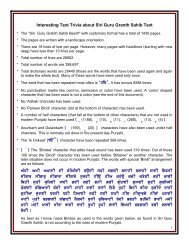Useful fonts manual - gurbanifile - Gurbanifiles.org
Useful fonts manual - gurbanifile - Gurbanifiles.org
Useful fonts manual - gurbanifile - Gurbanifiles.org
Create successful ePaper yourself
Turn your PDF publications into a flip-book with our unique Google optimized e-Paper software.
6<br />
Viewing Fonts in Detail<br />
It is important to emphasize the fact that even a good quality monitor will not display a<br />
very small size of characters with clarity (and for a very small size of text, Windows<br />
often will change the type-face to a proprietary one). This is mainly due to the limitations<br />
of display resolution. Print quality depends to a great extent on the printer you use. A<br />
good quality printer can print many times more dots per inch than what most of good<br />
monitors can display. Commonly used laser printers print 300 dots per inch or 90,000<br />
dots per square inch, whereas most of the computer monitors show about 75 dots per<br />
inch or 5625 dots per square inch; the difference is 16 fold. However, most of the<br />
computer monitors have one distinct edge over most of the printers. Computer monitors<br />
can show many colors and each dot can display a color by picking among millions,<br />
whereas dots in most of the printers are printed with one bit mode (like black or white)<br />
and gray tones or colors are simulated by combining such dots.<br />
To have a real (detailed) look of any character shape it is important to view the<br />
character at a large point size. Most of present day word processors allow you to type<br />
large size of text. Text at point size of 100 or above may be used for a detailed look. As<br />
seen on the monitor, character shapes at small sizes are somewhat of a compromise,<br />
although those will be printed perfect with a good quality printer. Slim versions of <strong>fonts</strong><br />
give a clearer view of the smaller point sizes of text on the monitor than medium or thick<br />
versions of <strong>fonts</strong>. Depending on your printer, thinner versions of <strong>fonts</strong> will generally print<br />
smaller sizes of text sharper than thicker <strong>fonts</strong>.<br />
At certain point sizes, bolding of certain <strong>fonts</strong> (if you have installed bolder versions of<br />
these <strong>fonts</strong>) may not be obvious on the monitor. It is because pixels (dots) on the<br />
screen can not be divided into fractions. Under circumstances requiring pixel fractions<br />
for bolding of the text, the computer may not add a visible thickness to make bolding<br />
obvious. However, the text when printed with a good quality printer, will be perfectly<br />
bold if there is a bold version of the font installed in the system. (Note: if there is no<br />
installed bold version of a type-face then bolding is done by the software itself and is<br />
almost always obvious on the monitor. However, the printed bold text in such cases is<br />
not perfect like when a bold version of the font is available).<br />
Experience indicates that the PostScript Type-1 <strong>fonts</strong> seem to give better results as far<br />
as character clarity on the monitor is concerned and also to a good extent in printing.<br />
Due to internal limitations, the True-Type <strong>fonts</strong> often do not print or display complex<br />
characters well.<br />
Accessing Characters<br />
True Type type-face technology was originally designed by Apple for use on the<br />
Macintosh. Microsoft also licensed & developed “TrueType” for the Windows. So far as<br />
the use of the type-faces is concerned, presently there is not much difference between<br />
these environments. However, it is much easier to access type-face characters on the<br />
Macintosh that exceed the upper & lower case limit (94). It is due to the availability on<br />
the Macintosh of ‘Command’, ‘Option’ & ‘Shift + Option keys’. By pressing one or a<br />
All rights are reserved by the author, Kulbir S Thind, MD, 3724 Hacienda Street, San Mateo, CA 94403, USA.



